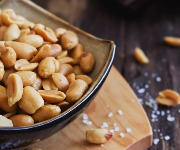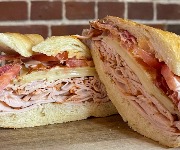The history of the clootie dumpling
Scotland's famous pudding, the Clootie Dumpling, is the perfect Burns Night treat for sweet-toothed revellers. But there's more than one way to make this traditional pud.
The clatter and bubble of a suet pudding boiling in a pot can warm a person faster than any radiator. It fills the kitchen with a warm fug of sugar and spice and when facing a dark Scottish winter, I can’t think of a better way to fight the cold than with a slab of Clootie Dumpling and a lake of custard.
The pudding gets its name from the cloth – the cloot or clout – it’s boiled in. You can steam a clootie dumpling in a greased pudding basin, but then it won’t really be a proper clootie. It’ll be just another version of the dried fruit and suet puds that have sustained workers and brightened festivals for centuries in Britain.
Before there were ovens
Although flour, suet, dried fruit and spices always feature, the precise ingredients vary from region to region and family to family. The cloth, however, is constant – a reminder of the days before ovens, when family meals were boiled in a pot.
Dumpling makers in Fife leave the breadcrumbs out and add treacle, creating a darker, heavier pudding that has much in common with its English cousin, the Christmas pud. Maw Broon, the matriarch of the Sunday Post’s comic strip family, includes a grated apple in her clootie, while other ‘essential’ ingredients that have made it into the mix include orange and lemon zest, grated carrot, rum, milk stout, oatmeal, beaten eggs and butter.
Keep it in the family
One of the reasons for this variety of dumplings is that recipes were handed down through the family rather than written down and published. The 1929 edition of F Marian McNeill’s The Scots Kitchen: Its Lore & Recipes features one of the earliest printed recipes.
Similar suet puddings appear in 18th and 19th century Scottish cookbooks, but the dish we know as Clootie Dumpling was a family dish that didn’t need recording – everyone had their own recipe. The standardised recipe had to wait for the 20th century and for boiled puddings to go out of fashion before it was written down for posterity.
Taste of tradition
Like all traditional puddings, clootie dumplings come with their own set of traditions. When it's being made everyone should give it a good skelp – or smack – to make sure it has a nice round shape. Charms also get stirred in so diners get a piece of their future with their slice of pudding. Finding a coin means wealth; a ring signifies marriage; and a wishbone promises the finder their heart’s desire. The man who finds a button and the woman who gets a thimble are destined to stay single.
However it’s made, Clootie Dumplings remain popular for celebrations – particularly for the Daft Days between Christmas and Hogmanay. It’s also popular for Burns Night (especially with those who want to celebrate with a pudding but can’t face the visceral nature of a haggis), birthdays and fried with bacon for breakfast.
If you don’t have your granny’s recipe to rely on, click here for my clootie dumpling recipe.
Fancy another helping of traditional puds?
This is a classic lovefood article
The first rule of pudding club is…
Gary Rhode’s bread and butter pudding
Jassy Davis’ sticky toffee pudding
Mark Hix’s apple and cider pudding
Slideshow created with Admarket's flickrSLiDR.
Most Recent
Comments
Do you want to comment on this article? You need to be signed in for this feature








